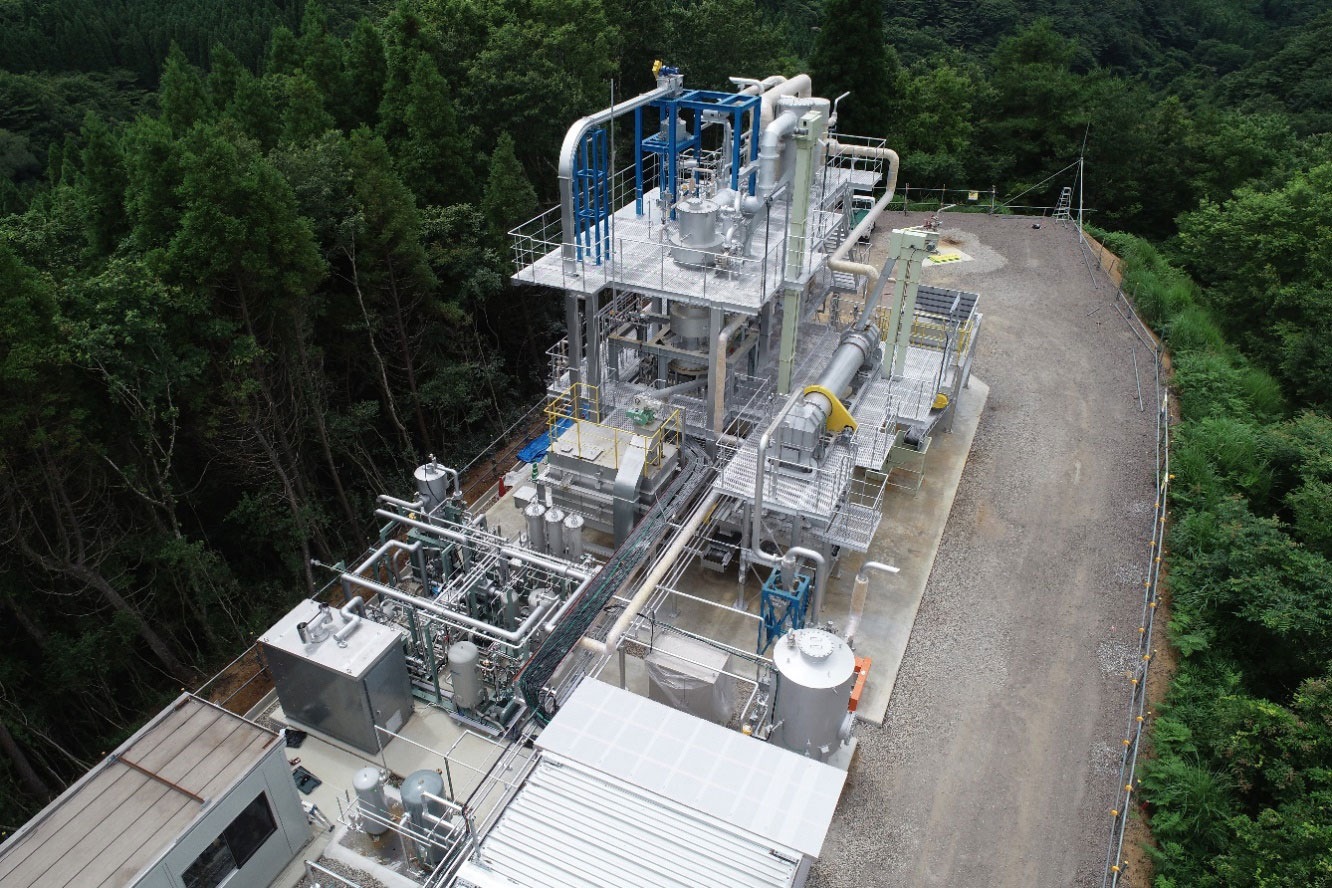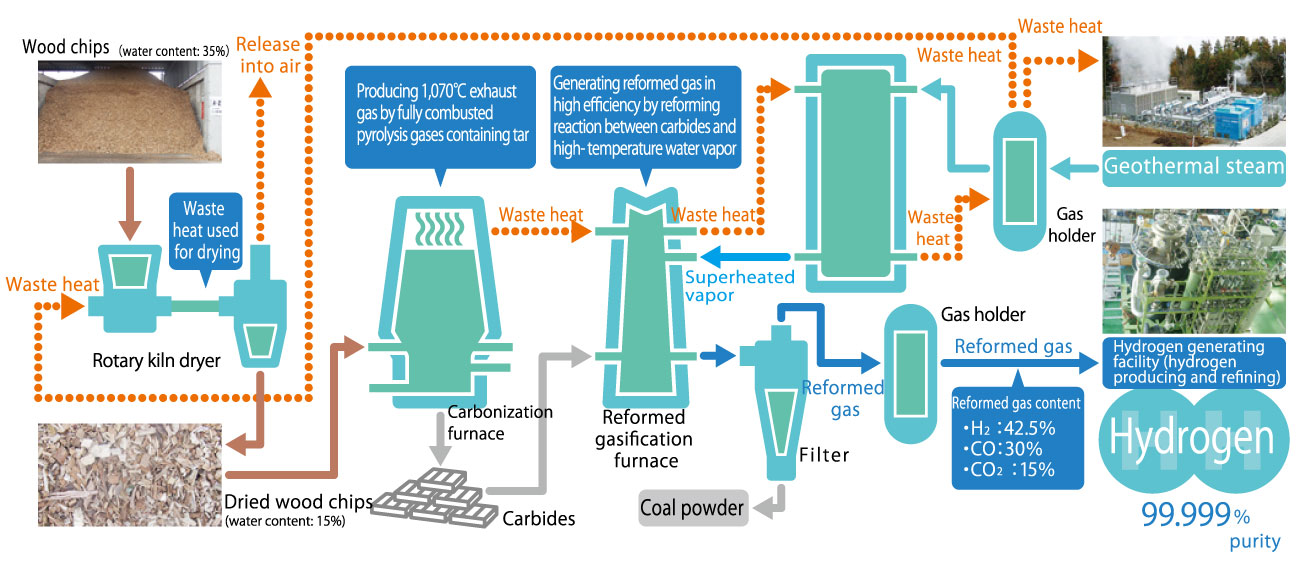July 28, 2022
Shimizu Corporation (President: Kazuyuki Inoue) announced today that it has completed demonstration plant to a low-cost method of green hydrogen generation in Kokonoe Town, Oita Prefecture. It had started construction last November. Ahead of the plant’s trial slated to begin in August, an opening ceremony will be held today at the site with 30 attendees, including Akira Tsukishima, Director of Kyushu Regional Environment Office, Ministry of Environment, Kazunari Yoshida, Deputy Governor of Oita Prefecture, and Yasushi Hino, Mayor of Kokonoe Town.
Shimizu was commissioned to build this demonstration plant as part of the Technology Development and Demonstration Project for Regional Symbiosis and Cross-Sectoral Carbon Neutrality run by the Ministry of Environment. The low-cost green hydrogen generation technology was developed in corroboration with Ichikawa Office Ltd. (Shinjuku-ku, Tokyo), Enecycle, Inc. (Osaki City, Miyagi), Dainichi Machine and Engineering Co., Ltd. (Yokohama City, Kanagawa), and HYDRONEXT Inc. (Oita City, Oita). The above method offers two key advantages: First, its energy sources, geothermal and biomass, are both plentiful in Japan. It will be tested with goal of carbon emissions produced during hydrogen generation are just a tenth of those produced in the generation of commercial (grey) hydrogen, while generation costs are just third of the costs of conventional methods for generating green hydrogen (such as by solar energy and water electrolysis).
The trial will involve 25-day continuous operation in three separate periods from August to December 2022. It will examine hydrogen generation at rate of 50Nm3 per hour and a purity 99.999% or higher using cedar chips as a biomass resource and geothermal steam. The trial will also verify the plant operates stable in terms of both quality and safety. The hydrogen generation cost that estimated by production efficiency, and CO2 emissions reduction rate will be calculated. The result will be reported to the Ministry of Environment in March 2023.
Shimizu plans to build on the findings of the demo and self-developed such demo plants built next to small or medium geothermal power stations. Commercial plants are expected to produce hydrogen at a rate of 250 -1,000 Nm3 per hour.
≪For Reference≫
Aerial Photograph of the Completed Hydrogen Generation Plant

Overview of Companies Involved in the Joint Development
| Name | Ichikawa Office Ltd. |
|---|---|
| Representative | Masaru Ichikawa |
| Address | Yotsuya, Shinjuku-ku, Tokyo |
| Contact | 81-3-5579-8946 |
| Capital | 3 million JPY |
| Date established | March 2006 |
| Summary of business | Development of technology for biomass gasification |
| Name | Enecycle Inc. |
|---|---|
| Representative | Yukimitsu Nomura |
| Address | Osaki City, Miyagi |
| Contact | 81-229-72-2010 |
| Capital | 100 million JPY |
| Date established | July 2015 |
| Summary of business | Development of technology for biomass carbonization and gasification |
| Name | Dainichi Machine and Engineering Co., Ltd. |
|---|---|
| Representative | Hideyuki Tosu |
| Address | Yokohama City, Kanagawa |
| Contact | 81-45-311-6803 |
| Capital | 50 million JPY |
| Date established | October 1965 |
| Summary of business | Plant design and construction |
| Name | HYDRONEXT Inc. |
|---|---|
| Representative | Masaaki Nagai |
| Address | Oita City, Oita |
| Contact | 81-97-529-5756 |
| Capital | 23.9 million JPY |
| Date established | December 2015 |
| Summary of business | R&D hydrogen refineries |
Conceptual Diagram of the Hydrogen Generation System

The demo facility will consist of a carbonization furnace fuelled by wood chips, a steam-reforming reactor for gasifying carbonaceous materials, and a hydrogen refinery. The generation process begins by steaming wood chips in the carbonization furnace to extract carbon from the biomass. The carbon is then injected into the reactor, where it comes into contact with steam and heat, produced by heating the furnace to over 800 ℃. The high temperature causes the carbon to react with the steam, forming biomass gas(also known as syngas), which consists of hydrogen (H2), carbon monoxide (CO), and carbon dioxide (CO2), and steam (H2O).
The biomass gas is reheated to induce a shift-reaction that increases the H2 concentration. Finally, it is refined using a pressure swing adsorption (PSA) system and metallic membrane for hydrogen separation. The result is green hydrogen (with a purity of at least 99.999%) ready for use in fuel cells.
The hydrogen generation process is fuelled by a high-temperature (1,070 ℃) gas emitted from the carbonization furnace. This fuelling method significantly reduces the cost of hydrogen production in that it minimizes electricity consumption and because the high-temperature exhaust heat can be sold to increase the geothermal electric power by the additional-boil-up of the geothermal steam. The high-temperature gas is itself generated by the atmospheric combustion of by-products from the carbonization furnace, including pyrolysis gas and tar.
The information contained in this news release is the current information on the date of publication. Please be aware that this information may have changed by the time you view it. Please contact the company to inquire for further details.
